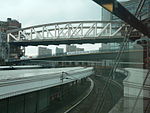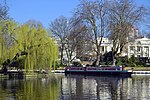Paddington tube station (Circle and Hammersmith & City lines)

Paddington is a London Underground station served by the Circle and Hammersmith & City lines. It is located adjacent to the north side of Paddington mainline station and has entrances from within the mainline station and from Paddington Basin. The station is between Royal Oak and Edgware Road and is in London Fare Zone 1. The station is one of two separate Underground stations of the same name. The other station, on Praed Street to the south of the mainline station, is served by the Bakerloo, Circle and District lines. Although shown on the London Underground map as a single station, the two stations are not directly linked and interchange between them is via the concourse of the mainline station.
Excerpt from the Wikipedia article Paddington tube station (Circle and Hammersmith & City lines) (License: CC BY-SA 3.0, Authors, Images).Paddington tube station (Circle and Hammersmith & City lines)
Chilworth Street, London Paddington
Geographical coordinates (GPS) Address Nearby Places Show on map
Geographical coordinates (GPS)
| Latitude | Longitude |
|---|---|
| N 51.518578 ° | E -0.17847 ° |
Address
London Paddington Railway Station
Chilworth Street
W2 3QU London, Paddington
England, United Kingdom
Open on Google Maps










